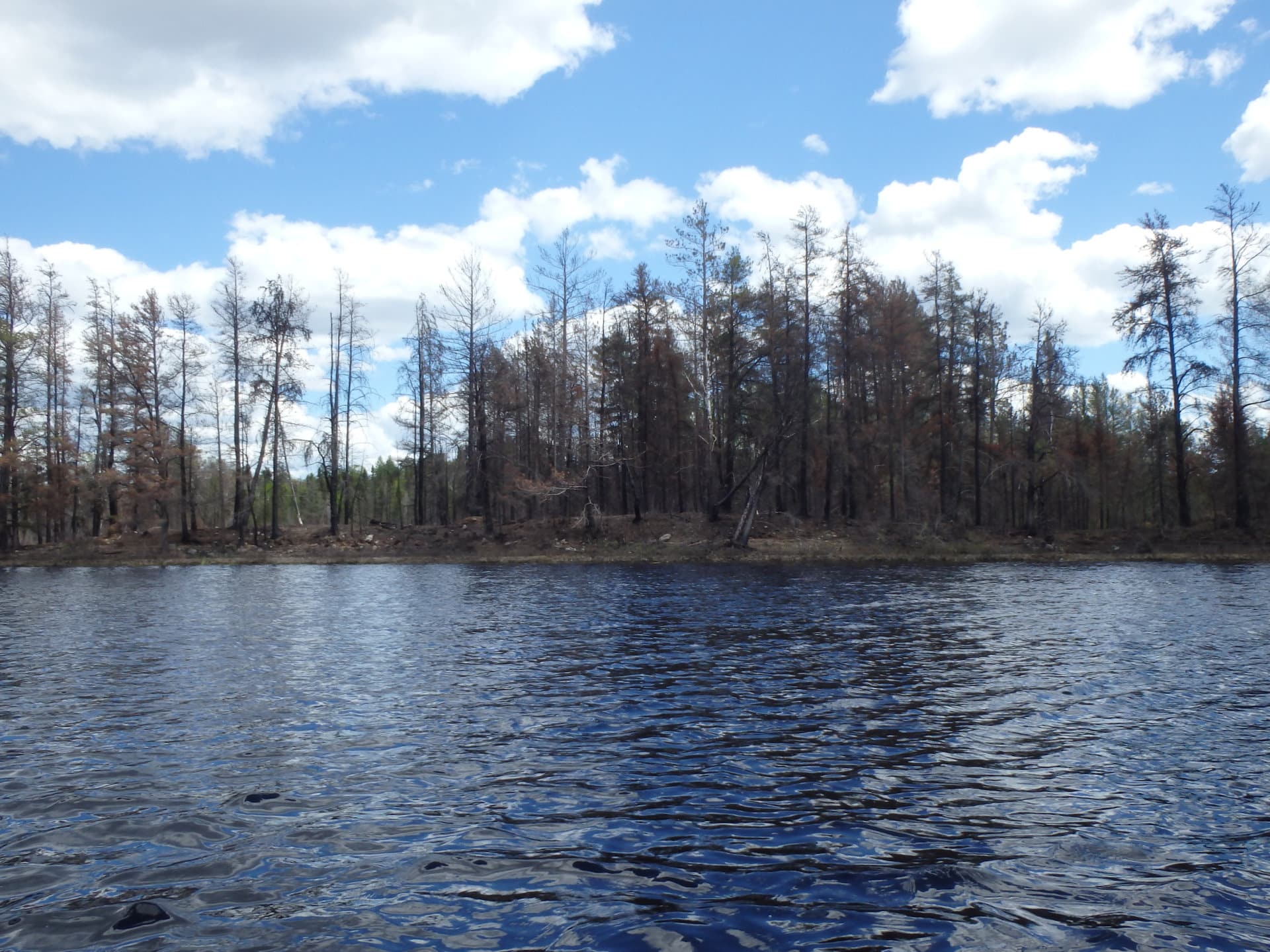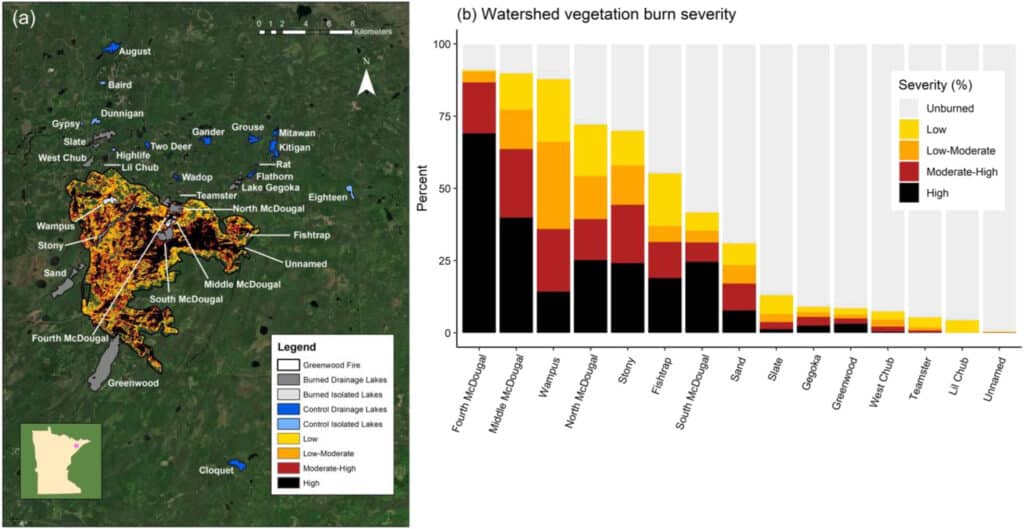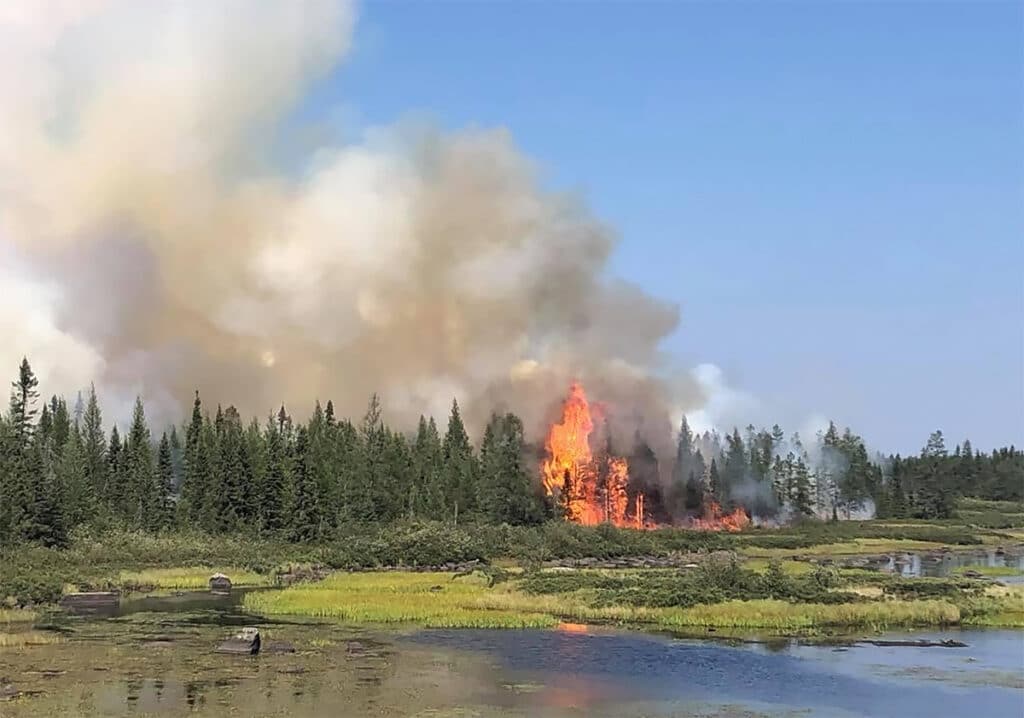
A new study has helped explain the connection between forest fires and water quality in the Superior National Forest. Researchers from several institutions intensively studied several lakes in areas near the Greenwood Fire, which burned 26,000 acres near Isabella in 2021, to analyze how such blazes can affect northern Minnesota’s lakes.
The fire forced the evacuation of nearly 300 residences for up to a month, destroying or damaging 17 buildings. It took some 400 firefighters from around the country three weeks to fully contain it. It also provided a sudden opportunity for a team led by the University of Minnesota’s Natural Resources Research Institute (NRRI). Thanks to a special federal program designed for such urgent research, they were able to take measurements of the lakes beginning in the spring following the fire.
“The fire was in the fall and we were in the water by May, within a week of ice-out,” said project coordinator and lead field technician Jerry Henneck of the NRRI. “That’s impressive because it usually takes a year to get a grant application in and another year for funding.”
Extensive effort
Henneck pulled together a large team from several other institutions to quickly mobilize. Partners included Michigan State University, whose Ian M. McCullough was lead author on the publication, the Minnesota Pollution Control Agency, the U.S. Geological Survey, University of Montreal, and the University of California. The first paper from the project was published last month in the peer-reviewed journal Geophysical Research Letters.
“Unlike previous studies that simply compared burned and control groups, we analyzed water quality responses along gradients of watershed and shoreline burn extent and severity,” the researchers wrote.

The big and diverse group made it possible to do intensive sampling work on 30 lakes in the National Forest. Fifteen of the waterbodies were within areas affected by the Greenwood Fire, and the other 15 were nearby but outside the burn area. Crews visited each lake monthly from May to September of 2022.
“We typically sampled six lakes a day,” said Henneck. “Some days we could get to eight or ten if they were near a road. And some days we could only get to three in a 12-hour day, through mud and bogs and swamps and over beaver dams.”
In many cases, the team provided the first water quality data ever collected for that lake, or the first in a very long time. The data is being provided to any and all other researchers who may wish to use it.

Fire and water
What the scientists found was that the fire had a major effect on nearby lakes. When trees and ground vegetation were burned off, soil, ash, and other material washed into nearby bodies of water. That material carried phosphorus and nitrogen, which can fuel algae growth. But, the researchers also did not observe much algae growth, possibly because the water was clouded from the runoff and therefore not as much light could reach aquatic plants.
“By conducting the largest-ever lake-wildfire study in an understudied, lake-dense region where wildfire was historically prevalent, we add to growing knowledge of lake responses to wildfire by highlighting the importance of burn pattern and severity, hydrologic connectivity, lake and watershed variables, and intra-annual water quality dynamics,” the researchers wrote.
Wildland fires have also been studied in Minnesota in how the erosion they cause can contribute to mercury pollution. Research in the Boundary Waters Canoe Area Wilderness and Voyageurs National Park in recent decades has examined if fire erosion can carry mercury from where it spread by the atmosphere across land, and concentrate in the fish of downstream lakes.
In 2009, research by the U.S. Geological Survey in Voyageurs found that large amounts of mercury “mobilized” by a fire did not appear to affect levels in lakes or fish. A study by the Forest Service in 2017 also found that levels of mercury in fish were not elevated by a small prescribed fire in the BWCAW, comparing yellow perch from two watersheds.
More information:
- Study reveals new information about wildfire impact to lakes – Natural Resources Research Institute
- Study: Wildfire led to poorer water quality in northern Minnesota lakes – MPR News
References:
McCullough, I. M., Brentrup, J. A., Wagner, T., Lapierre, J.-F., Henneck, J., Paul, A. M., et al. (2023). Fire characteristics and hydrologic connectivity influence short-term responses of north temperate lakes to wildfire. Geophysical Research Letters, 50, e2023GL103953. https://doi.org/10.1029/2023GL103953
Woodruff, L.G., Sandheinrich, M.B., Brigham, M.E., and Cannon, W.F., Impact of wildfire on levels of mercury in forested watershed systems—Voyageurs National Park, Minnesota: U.S. Geological Survey, Scientific Investigations Report 2009–5151, 19 p. plus appendices, available online only at http://pubs.usgs.gov/sir/2009/5151/.
Riggs, C.E., Kolka, R.K., Nater, E.A., Witt, E.L., Wickman, T.R., Woodruff, L.G. and Butcher, J.T. (2017), Yellow Perch (Perca flavescens) Mercury Unaffected by Wildland Fires in Northern Minnesota. J. Environ. Qual., 46: 623-631. https://doi.org/10.2134/jeq2016.10.0418

